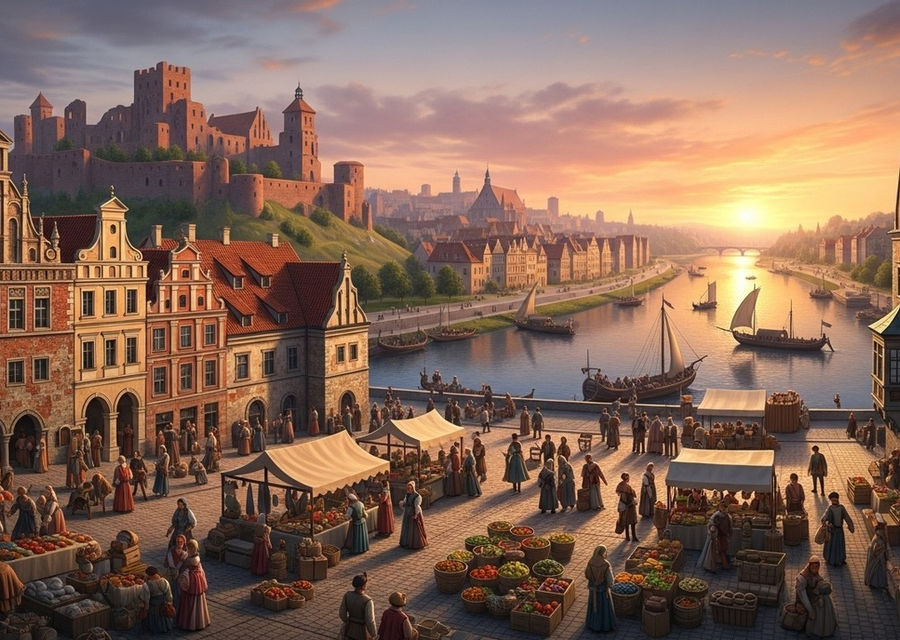Świecie Poland history: A Riverside Town's Tapestry of Trade and Resilience
- THE MAG POST

- Aug 25
- 14 min read

Świecie Poland history unfolds along the Vistula’s western shore, where timbered houses and Gothic facades look out over water highways that have carried goods and ideas for centuries. From a modest fishermen’s village to a royal town, Świecie's fortunes rose with the Amber Road, drawing merchants, craftsmen, and travelers through a crossroads of cultures. Fires, plagues, and wars punctuated its timeline, yet new markets and rail lines stitched resilience into daily life. Its architectural palimpsest—Gothic, Renaissance, Baroque, Neo-Gothic—speaks of layered identities, while institutions like the firefighting museum and early psychiatric hospital anchor memory in the landscape.
From Fishing Village to Royal Market Town
A concise origin story begins with a riverside village whose fortunes mirrored the region’s shifting sovereignties. In the Early Middle Ages, Świecie grew from a fishermen’s settlement into a meaningful node as the Polish state consolidated its frontiers in the 10th century. The area formed part of the emerging realm as the duchies of Pomeranian lineages asserted authority, and the town’s status as Civitas signaled urban ambitions on par with larger neighbors. Over time, governance and commercial activity aligned with the noble courts and royal prerogatives, laying groundwork for a distinct urban rhythm.
Two pivotal transitions defined this early trajectory. First, the Teutonic Order’s emergence altered the balance of power in the late medieval period, granting municipal rights and shaping a new legal framework. Second, a devastating fire and ensuing relocation moved the town down toward the river valley, where the Vistula’s bend offered protection and opportunity. These moves did not erase Świecie’s character; they amplified its role as a crossroads where trade, culture, and faith intersected, producing a tapestry of streets, guilds, and sacred spaces that endured into the modern era.
Founding and Early Settlement in Świecie Poland history
In its foundational chapters, Świecie allied with the broader Polish state as a frontier town on the edge of evolving trade routes. The locality benefited from a fisherfolk heritage that evolved into a merchant culture, with craftspeople and traders contributing to a growing market network. The town’s early layout reflected a balance between defensive needs and economic vigor, with the market square acting as a social anchor and a space where announcements, judgments, and festivals came alive. This period established a sense of place that would echo through centuries of change and continuity.
Religious and cultural institutions emerged in tandem with commercial growth, embedding Świecie within a web of regional networks. Monastic lands, parish churches, and civic palaces began to define the skyline, while the surrounding countryside supplied grain, timber, and salt that fed the town’s growing population. The synergy of riverine transport and overland routes created a robust economy that could absorb shocks—from epidemics to fires—without losing its essential character as a trading hub along the amber lanes of northern Poland.
Urban Fabric and Royal Affiliation in Świecie Poland history
The 14th and 15th centuries witnessed a shift from scattered villages to a more disciplined urban plan, as Świecie acquired formal municipal governance under evolving royal oversight. The town’s architecture began to reflect prestige: stone houses, defensive walls, and public buildings signaled a degree of status that attracted artisans and merchants from across the region. The Amber Road’s corridors threaded through Świecie, turning it into a commercial fulcrum where Baltic and Baltic-adjacent goods mingled with local produce, crafts, and salted fish. The city’s public life thus blurred the lines between administration, commerce, and culture.
Intermittent conflict and political realignments tested this stability, yet the town retained its core identity as a market-laden, legally autonomous center. Guilds organized around crafts—from carpentry to textiles—kept a steady flow of goods and knowledge, while public rituals and ceremonies reinforced civic pride. Even amid upheavals, Świecie’s urban fabric endured, bearing witness to a community that valued both practical trade and shared memory as a basis for resilience.
Świecie Poland history: Geography as Destiny in Trade and Memory
Geography hardened Świecie’s destiny by locating it where water routes and land corridors converge. The town sits on the west bank of the Vistula at the confluence with the Wda, a position that amplified its role as a gateway between Western Pomerania, Warmia, Masuria, and Lithuania. The riverine landscape created natural routes for goods, people, and ideas, while the town’s compact core kept administration and commerce intimately linked. The result is a place whose spatial logic remains legible in its street patterns, market spaces, and waterfronts, echoing centuries of movement and exchange.
Beyond rivers, Świecie’s location aligned with broader historical currents. The Amber Road, a caravan trail of resin and craft, threaded through the region and connected Świecie to distant markets, reinforcing its significance in the pre-modern economy. This confluence of waterways and terrestrial routes forged a layered infrastructure—bridges, quays, warehouses—that supported a lively trade ecosystem. In effect, the geography did not merely shape commerce; it shaped the town’s social structure, cultural exchange, and long-term identity as a hinge between sea, land, and inland territories.
Rivers as Trade Arteries in Świecie Poland history
Rivers acted as arteries that moved goods and people with a rhythm that markets could rely upon. The Vistula’s broad swath carried timber, grain, and salt downstream while bringing imported luxuries upstream, creating a cycle of exchange that sustained livelihoods and local masters. The Wda joined this flow, serving as a complementary channel that opened additional docking points and storage spaces along Świecie’s waterfront. This hydraulic network enabled merchants to time shipments, adjust supply chains, and coordinate seasonal fairs that boosted the town’s standing among neighboring towns and estates.
The convergence of these waterways also fostered cultural exchange. Sailors, clerks, and priests brought news from distant regions, while merchants introduced new fabrics, tools, and techniques. The town’s social fabric expanded as people of different languages and faiths encountered one another in markets and on barges. The result was a cosmopolitan undercurrent within Świecie’s otherwise practical, river-driven economy, a pattern that endured long after the glow of medieval trade lights dimmed in later centuries.
Amber Road and Northern Trade Networks in Świecie Poland history
The Amber Road’s north-south corridors threaded Świecie into a grander network that linked the Baltic Sea with central and eastern Europe. Amber, a coveted commodity, moved through marketplaces, altars, and bartering houses, weaving Świecie into a web of regional power dynamics. Local traders learned to read seasonal tides and caravan timetables, honing the art of negotiation in settings that ranged from open-air squares to chapels and town halls. This cross-border commerce not only enriched the local economy but also seeded cultural practices, crafts, and architectural motifs that would leave a durable imprint on the town’s heritage.
Over time, the Amber Road’s significance evolved as political borders shifted. Świecie’s merchants adapted to new patrons and new currencies, yet the underlying logic of exchange—quality, reliability, and speed—remained constant. The town thus cultivated a reputation for dependable trade and a readiness to collaborate with distant markets, a tradition that can be observed in the later railway era and ongoing cultural exchange that continues to define Świecie’s place in the region.
The Teutonic Era and City Rights
One of the defining chapters of Świecie’s story concerns the Teutonic Order’s ascent and the town’s legal evolution under their rule. By the early 14th century, Świecie had already achieved Civitas status, signaling a mature urban identity comparable to major Baltic towns. The Order’s governance brought a formal municipal framework, codified privileges, and a sense of strategic importance that mirrored its proximity to contested routes and regional powers. In the wake of fires and relocations, the town’s governance adapted, preserving its autonomy while aligning with the order’s broader administrative network.
During the mid-1400s, Świecie became entangled in the Thirteen Years’ War, and the 1454 Prussian Confederation event catalyzed a re-incorporation into Poland upon Casimir IV’s demand. The Teutonic Knights renounced their claims in 1466, and Świecie emerged as a county seat within Royal Prussia in the Greater Poland Province. This period cemented Świecie’s role as a local center of justice, commerce, and culture, integrating it into Poland’s evolving state structure while preserving a distinctive urban identity shaped by cross-cultural interactions and defensive considerations along the Vistula corridor.
Municipal Privileges under the Teutonic Order
Under Teutonic tutelage, Świecie acquired a suite of municipal privileges that defined its civic life. Local councils, guild regulations, and taxation frameworks provided a measure of self-government within a larger hierarchical system. The town’s citizens could participate in public decision-making, secure legal protections, and benefit from predictable revenue streams that supported markets, fairs, and public works. These privileges also fostered a bustling marketplace where merchants and artisans could prosper, reinforcing Świecie’s reputation as a well-governed, trade-ready town on the frontier of empire and nation.
The privileges extended to urban development as well, encouraging the construction of durable public spaces, religious houses, and protective infrastructure. The town’s layout reflected strategic concerns—defensive walls, gatehouses, and a centralized market square—while enabling the growth of crafts and services that sustained daily life. In this environment, residents and visitors encountered a governance model that balanced practical administration with a shared sense of community identity and resilience.
Relocation and Urban Realignment in Świecie Poland history
The 14th–15th centuries brought a notable relocation of Świecie’s urban center from the high western bank to the river valley. The shift, plausibly prompted by fires and flood risks, reoriented trade routes, reshaped the market’s footprint, and reconstituted the town’s spatial hierarchy. The valley location offered better access to ships and quays while still preserving commanding views of defensive lines. This realignment demonstrates how Świecie’s leadership leveraged natural geography to sustain economic vitality and strategic advantage, even as the town navigated tectonic shifts in political authority.
Subsequent centuries built on this spatial reconfiguration, with new buildings, churches, and civic complexes rising to serve a growing population. The rebuilt urban fabric became a visual chronicle of perseverance, reflecting the town’s ability to adapt to changing regimes while preserving core functions—trade, governance, and faith—that defined its public life. The resulting skyline remains a testament to deliberate urban planning under shifting powers and persistent self-identity.
Partitions, Prussia, and Reunification
The late 18th century brought new geopolitical realities as Świecie fell under the First Partition of Poland and was absorbed into the Kingdom of Prussia, later becoming part of West Prussia. The administrative shift reoriented regional loyalties, language policies, and economic frameworks. Yet the town’s strategic value as a trade node persisted, and modernization efforts gradually integrated Świecie into the burgeoning German imperial economy. Rail links, in particular, catalyzed growth, linking Świecie more closely with continental markets and enabling a more diverse labor force to contribute to industrial expansion.
After World War I, the town’s fate swung back toward Poland following the Versailles border arrangements. In 1920 Świecie was restored to the Second Polish Republic and placed within the Pomeranian Voivodeship. The era also saw public administration restabilize under Polish leadership, with local figures like Stanisław Kostka guiding flood defense improvements and fostering cultural development. This reconciliation of borders did not erase Świecie’s cross-cultural memory; it instead enriched the town’s ability to adapt, grow, and collaborate across communities in a changing national landscape.
First Partition and West Prussia Integration
Świecie’s incorporation into West Prussia placed it within a new provincial structure that emphasized railway connectivity and industrial expansion. The shift catalyzed demographic changes, with new workers arriving to staff plants, mills, and transport hubs. The town’s governance adapted to German administrative norms, yet local traditions endured, including markets, religious rituals, and public commemorations that remained familiar to long-time residents. The interlude under Prussian administration introduced a bilingual dimension to civic life, foreshadowing the complex identity Świecie would carry into the interwar years.
Industrialization accelerated as trains stitched Świecie to a wider European economy. Factories and workshops flourished, while public services expanded to support a growing urban population. The years preceding World War II saw a town poised for continued growth, balancing a legacy of Polish memory with the practicalities of a multilingual, multiethnic urban environment. This epoch set the stage for the turbulence and transformation that would follow in the mid-20th century.
Return to Poland and Interwar Development
Postwar realignments re-rooted Świecie in Polish sovereignty, and the town entered a phase of infrastructural and cultural modernization. Local leaders focused on flood control, public health, and education, improving the living standards of residents while preserving a shared regional heritage. The arrival of industrial plants, including paper and sugar facilities, diversified the economy and created stable employment for generations. The interwar period also fostered a public sphere that appreciated civic institutions, local history, and regional cooperation with neighboring towns and counties.
This era also witnessed a re-emergence of public monuments and cultural life, signaling a return to normalcy after the upheavals of partition and early 20th-century conflict. Świecie’s revival was not merely economic; it was a reinvigoration of community identity, with schools, clinics, and theaters playing central roles in daily life and memory.
Industrial Growth, Railways, and Demography
Industrial growth reshaped Świecie’s social and physical landscape as the late 19th and early 20th centuries unfurled. A railway connection in 1888 linked the town with broader markets, triggering a population surge and a shift toward factory-based employment. The arrival of modern industries, including a flourishing sugar refinery and paper production, redefined the local economy, drawing workers from surrounding countryside and neighboring provinces. The town’s demographics grew increasingly diverse, reflecting the era’s urbanization and the cross-border flows that characterized East-Central Europe.
By the early 20th century, Świecie displayed a mixed linguistic profile, a mirror of regional dynamics that included German- and Polish-speaking communities. The census data from 1910 show a nearly balanced distribution, highlighting a cosmopolitan local culture and the practical realities of daily life in a borderland settlement. Public life adapted to the multilingual, multiethnic reality, while infrastructure improvements and civic organizations reinforced social cohesion and resilience through periods of transformation and tension.
Railway Era and Economic Leap in Świecie Poland history
The railway era acted as a lever for economic expansion, enabling faster movement of goods, people, and ideas. Stations, depots, and associated industries sprouted along the tracks, while the town’s commercial core grew to accommodate a larger and more varied clientele. The transport network also integrated Świecie into regional and national supply chains, facilitating the distribution of agricultural products, timber, and manufactured goods. This connectivity underpinned a new dynamism in civic life, from markets and schools to cultural venues and municipal services.
Industrial growth was not merely a matter of profit; it also reshaped community life. New employment opportunities attracted families, altered housing patterns, and prompted public investments in health, education, and recreation. The town’s workforce became more specialized, while small-scale crafts persisted alongside larger plants, creating a balanced economy that could weather fluctuations in demand and broader economic cycles. This period thus marked a turning point in Świecie’s long history of adaptation and renewal.
World Wars and Aftermath
The upheavals of the 20th century left an indelible imprint on Świecie. Nazi occupation beginning in 1939 brought repression and mass violence, with the region subjected to brutal administrative measures and tragic crimes against Polish citizens and intellectuals. The town was incorporated into Reichsgau Danzig-West Prussia, and local residents faced indiscriminate arrests, expulsions, and persecution. The scars of these years are etched into memories, landscapes, and the chronicles preserved by survivors and witnesses who documented the hardships endured by families and communities on the Vistula front.
The town’s liberation in 1945 by Polish and Soviet forces initiated a complex postwar transformation. An internment camp for German residents operated briefly as a mechanism of forced labor adjustments, after which Świecie was restored to Poland and reorganized within the Bydgoszcz Voivodeship. The aftermath spurred reconstruction, resettlement, and a renewed emphasis on public services, education, and memory culture. The wartime experience ultimately reinforced a local ethos of resilience and reconciliation, shaping contemporary life and regional cooperation well into the modern era.
Occupation and Liberation in Świecie Poland history
The wartime years tested the town’s social fabric as German forces imposed authoritarian governance and committed acts of violence against Polish communities. The occupation disrupted daily routines, displaced families, and redirected economic life toward the mechanisms of occupation and exploitation. Local memory preserves the testimonies of victims, survivors, and resistance figures, ensuring that the town’s darker chapters inform future generations. The liberation in 1945 restored sovereignty and reopened channels for rebuilding civic life, education, and cultural institutions that would anchor Świecie’s postwar recovery.
In the immediate aftermath, efforts concentrated on restoring essential services, repairing infrastructure, and supporting demobilized workers. The transformation also involved reestablishing Polish governance, restoring churches and schools, and gradually reintegrating the town into wider regional development programs. This period of reconstruction cultivated a sense of shared purpose, with communities collaborating across sectors to re-create a livable, prosperous Świecie that honored its multifaceted past while embracing a rebuilding future.
Culture, Institutions, and Memory
Świecie’s cultural landscape is reinforced by a constellation of museums, schools, and public organizations that preserve memory and foster learning. The region houses a dedicated Museum of Firefighting, whose exhibits trace the evolution of emergency services and community defense, offering visitors a tactile link to local history and civic responsibility. Educational institutions and civic associations contribute to a robust culture of discourse, providing venues for lectures, exhibitions, and community events that celebrate regional identity and shared heritage. These institutions anchor memory in daily life and invite ongoing engagement with the town’s past.
In addition to formal museums, Świecie’s architectural patrimony—Gothic, Renaissance, Baroque, Neo-Renaissance, and Neo-Gothic—serves as an open-air classroom. Public squares, churches, and guild halls illustrate the town’s evolving tastes and technological capabilities across centuries. The built environment thus embodies a living history, where students, residents, and visitors observe how design reflects social aspirations, religious traditions, and commercial vigor. Festivals, markets, and commemorations keep these memories vital, linking past and present through shared experience and collective storytelling.
Heritage and Public Memory in Świecie Poland history
The preservation of heritage in Świecie is not a static display; it is an active practice that involves restoration, documentation, and inclusive storytelling. Local authorities collaborate with cultural organizations to safeguard monuments, maintain historical districts, and promote responsible tourism that respects daily life and local livelihoods. Community-led initiatives aim to interpret the town’s diverse epochs—medieval, early modern, industrial, and postwar—in ways that resonate with residents and visitors alike. This collaborative approach ensures that memory remains a living, participatory process rather than a passive archive.
Public memory also emphasizes education, with curricula and outreach programs designed to illuminate Świecie’s role within broader Polish and European history. By telling multifaceted stories—about trade, conflict, resilience, and renewal—the town fosters critical reflection on the transformations that shaped its identity. In this sense, Świecie offers a model for how small towns can preserve specificity while contributing to a wider sense of shared history and cultural continuity.
Notable Figures, Institutions, and Local Legacies
Świecie’s legacy includes figures who shaped policy, culture, and sport, as well as institutions that anchored the town’s ongoing development. Among these is Stanisław Kostka, a locally prominent activist who steered flood control projects and economic initiatives that safeguarded the town’s future after 1920. The community also produced notable figures in the arts and sports, such as vocal artists, choreographers, and athletes who achieved recognition beyond regional boundaries. These individuals underscore Świecie’s capacity to nurture talent within a small urban milieu.
Public institutions, including schools and teams across football and basketball, reflect a community-oriented spirit that values teamwork, discipline, and civic participation. Clubs such as Wda Świecie and Polpak Świecie provide social glue, while educational groups and management schools signal an ongoing commitment to professional development and leadership. The town thus combines historical memory with contemporary vitality, maintaining a productive dialogue between its past and its present contributions to regional life.
Local Leaders and Cultural Figures in Świecie Poland history
Stanisław Kostka’s tenure as mayor brought practical improvements in flood defense and urban infrastructure, demonstrating how local leadership can translate memory into concrete benefits. The town’s cultural figures—from directors to athletes—represent a continuum of achievement that links Świecie to wider national narratives. These individuals exemplify how local communities can cultivate excellence across sectors, translating historical continuity into contemporary success. Their legacies show how small towns can influence national culture and policy through dedicated public service and exemplary performance.
Contemporary institutions ensure ongoing opportunity, with schools and cultural organizations fostering new generations of leaders. The interplay between history and modern practice creates a dynamic environment where residents feel connected to a broader story while shaping their own paths. This resonance between past and present makes Świecie a living example of how local heritage can empower future progress through education, sport, and public service.
The Final Take
In the closing arc of Świecie Poland history, the town emerges not as a relic of the past but as a continually evolving community that honors its layered heritage while embracing modern realities. Its strategic geography, its dynamic economy, and its commitment to memory and education coalesce into a resilient civic identity. From medieval markets to contemporary schools and museums, Świecie demonstrates how local history can illuminate broader regional narratives, offering a lucid case study in continuity, adaptation, and communal pride. The town’s story invites us to reflect on how small places keep large histories alive for generations to come.
Key lessons linger: celebrate diverse legacies, maintain civic infrastructure, and nurture memory as a living practice. As Świecie moves forward, its enduring lessons about trade, governance, and culture remain relevant to towns facing globalization, demographic change, and the challenge of preserving identity in a connected world. The final takeaway is simple yet powerful: history sustains communities when memory informs action and action honors memory.
Section | Key Highlights |
Introduction & Overview | Świecie Poland history as a riverine trade hub with Gothic and Baroque heritage. |
From Fishing Village to Royal Town | Early settlement, Civitas status, amber trade, and urban formation. |
Geography & Amber Trade | Vistula-Wda position; Amber Road connections and regional exchange. |
The Teutonic Era | Municipal privileges; relocation; Grunwald era implications. |
Partitions & Reunification | First Partition; West Prussia; Versailles-era return to Poland. |
Industrial Growth & Railways | Rail linkage in 1888; sugar/paper industries; demographic shifts. |
World Wars & Aftermath | Occupation, atrocities, Liberation, and postwar reorganization. |
Cultural Heritage & Institutions | Museum of Firefighting; Gothic-Renaissance-Néo styles; memory culture. |
Notable Figures & Local Legacies | Stanisław Kostka; local leaders; sports and arts figures. |
The Final Take | Continuity, adaptation, and memory guiding Świecie’s future. |






















































Comments